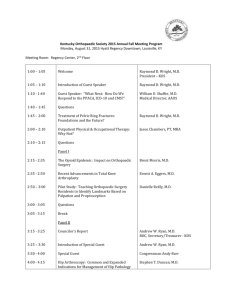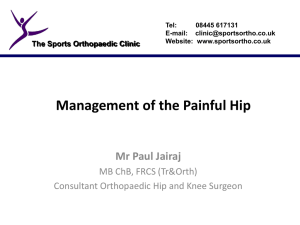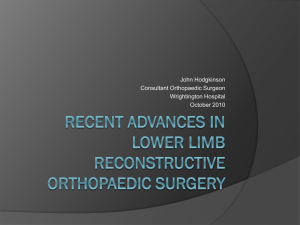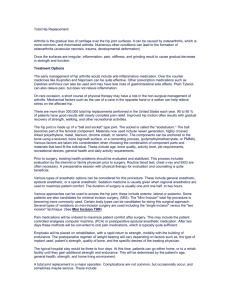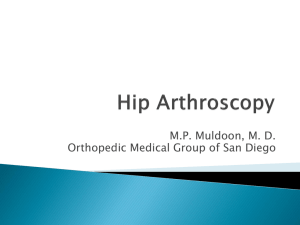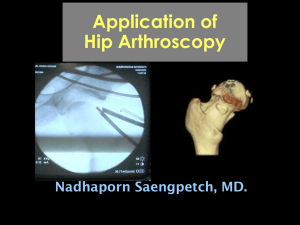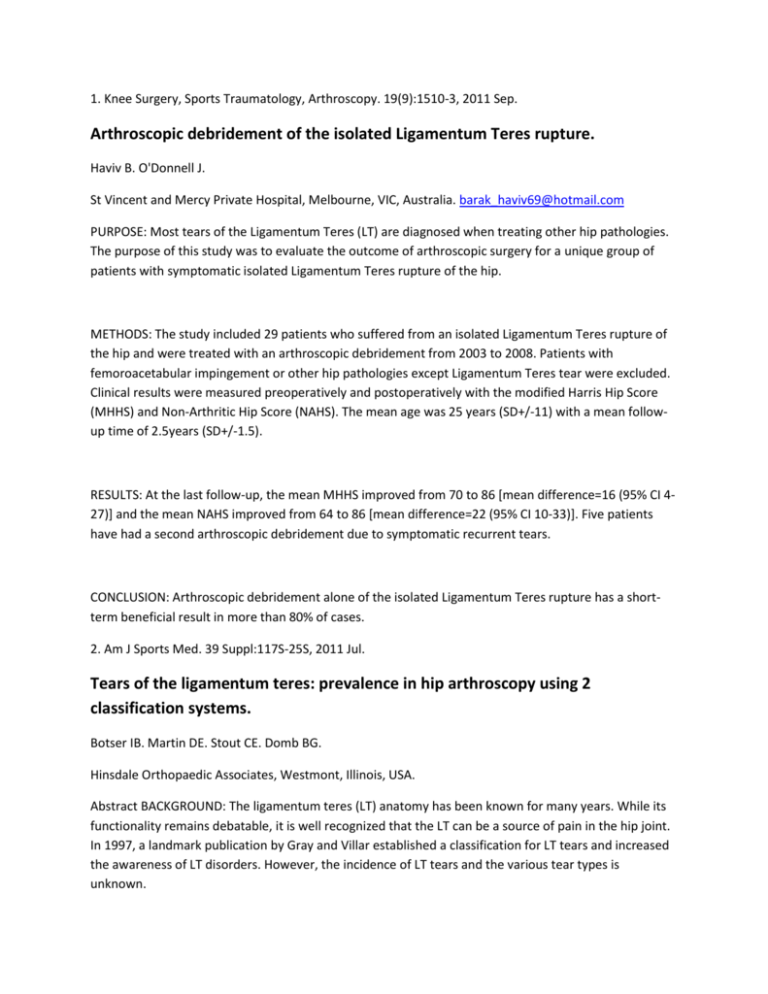
1. Knee Surgery, Sports Traumatology, Arthroscopy. 19(9):1510-3, 2011 Sep.
Arthroscopic debridement of the isolated Ligamentum Teres rupture.
Haviv B. O'Donnell J.
St Vincent and Mercy Private Hospital, Melbourne, VIC, Australia. barak_haviv69@hotmail.com
PURPOSE: Most tears of the Ligamentum Teres (LT) are diagnosed when treating other hip pathologies.
The purpose of this study was to evaluate the outcome of arthroscopic surgery for a unique group of
patients with symptomatic isolated Ligamentum Teres rupture of the hip.
METHODS: The study included 29 patients who suffered from an isolated Ligamentum Teres rupture of
the hip and were treated with an arthroscopic debridement from 2003 to 2008. Patients with
femoroacetabular impingement or other hip pathologies except Ligamentum Teres tear were excluded.
Clinical results were measured preoperatively and postoperatively with the modified Harris Hip Score
(MHHS) and Non-Arthritic Hip Score (NAHS). The mean age was 25 years (SD+/-11) with a mean followup time of 2.5years (SD+/-1.5).
RESULTS: At the last follow-up, the mean MHHS improved from 70 to 86 [mean difference=16 (95% CI 427)] and the mean NAHS improved from 64 to 86 [mean difference=22 (95% CI 10-33)]. Five patients
have had a second arthroscopic debridement due to symptomatic recurrent tears.
CONCLUSION: Arthroscopic debridement alone of the isolated Ligamentum Teres rupture has a shortterm beneficial result in more than 80% of cases.
2. Am J Sports Med. 39 Suppl:117S-25S, 2011 Jul.
Tears of the ligamentum teres: prevalence in hip arthroscopy using 2
classification systems.
Botser IB. Martin DE. Stout CE. Domb BG.
Hinsdale Orthopaedic Associates, Westmont, Illinois, USA.
Abstract BACKGROUND: The ligamentum teres (LT) anatomy has been known for many years. While its
functionality remains debatable, it is well recognized that the LT can be a source of pain in the hip joint.
In 1997, a landmark publication by Gray and Villar established a classification for LT tears and increased
the awareness of LT disorders. However, the incidence of LT tears and the various tear types is
unknown.
PURPOSE: The authors report the prevalence of LT tears in a population of patients who underwent hip
arthroscopy, using both the Gray and Villar classification and a new descriptive classification.
STUDY DESIGN: Case series; Level of evidence, 4.
METHODS: Between February 2008 and January 2011, 616 hip arthroscopies were performed by the
senior author. After excluding revision surgeries, a total of 558 surgeries (502 patients) were included in
the study. Data were collected regarding patients' demographics, mechanism of injury, range of motion,
magnetic resonance results, and intraoperative findings. Preoperative hip-specific questionnaire scores
and pain level were recorded as well. Ligamentum teres tears were classified according to Gray and
Villar's classification, and were also categorized using a descriptive grading system as follows: 0, no tear;
1, <50% tear; 2, >50% tear; or 3, 100% tear.
RESULTS: A total of 284 (51%) of the 558 surgeries in this cohort revealed LT tears. According to the
descriptive grading system, 22% were grade 1, 24% were grade 2, and 5% were grade 3. According to
the Gray and Villar classification 3.7% had full rupture, 43% had a partial tear, and 4.5% had a
degenerative tear. Patients with LT tears were significantly older and had worse preoperative functional
scores; they did, however, have a greater range of motion. Intraoperatively, an association with larger
labral tear size and acetabular chondral damage was found. Magnetic resonance arthrography was
found to have low accuracy and sensitivity in detection of LT tears. No correlation to the pain level was
found.
CONCLUSION: Ligamentum teres tears had a higher prevalence in this study than was published in the
past, most probably attributable to a lower threshold used in defining a tear. The incidence is defined
both using the Gray and Villar classification, as well as a new descriptive classification system that
categorizes the LT according to amount of tearing.
3. Arthroscopy. 27(3):436-41, 2011 Mar.
Arthroscopic reconstruction of the ligamentum teres.
Simpson JM. Field RE. Villar RN.
The Richard Villar Practice, Cambridge Lea Hospital, Cambridge, England. jm.simpson@rcsed.ac.uk
Abstract We describe a case of arthroscopic reconstruction of the ligamentum teres using a novel
technique. This technique is both simple and reproducible. We believe it to be a useful addition to the
procedures available to the arthroscopic hip surgeon. Copyright Copyright 2011 Arthroscopy Association
of North America. Published by Elsevier Inc. All rights reserved.
4. Arthroscopy. 27(4):486-92, 2011 Apr.
Hip arthroscopy after surgical hip dislocation: is predictive imaging possible?.
Dudda M. Mamisch TC. Krueger A. Werlen S. Siebenrock KA. Beck M.
Department of Orthopaedic Surgery, Inselspital, University of Berne, Switzerland. marcel.dudda@rub.de
Abstract PURPOSE: Our purpose was to study the sensitivity, specificity, and predictive values for hip
adhesionns, labral tears, and articular cartilage lesions in patients who had open treatment for
femoroacetabular impingement, had persistent symptoms, and had both magnetic resonance
arthrography (MRA) with radial slices and hip arthroscopy.
METHODS: Of 750 patients, 21 patients (6 male and 15 female patients; mean age, 28 years [range, 16
to 41 years]) with persistent groin pain after open osteochondroplasty and femoroacetabular
impingement were included. The mean time between open osteochondroplasty and hip arthroscopy
was 19 months (range, 4 to 79 months). At index surgery, patients had open osteochondroplasty of the
femoral head-neck junction, as well as resection of the acetabular rim with reattachment of the labrum.
All patients had preoperative MRA.
RESULTS: At hip arthroscopy, 1 tear of the labrum was verified on MRA. MRA showed in all patients
adhesions between the neck of the femur and joint capsule, which were confirmed at arthroscopy and
removed. Sensitivity of MRA for tears and adhesions was 100%; specificity, 100% and positive predictive
value (PPV), 100%. For acetabular cartilage damage, sensitivity was 66.7%; specificity, 77.8%; and PPV,
63.6%. For femoral cartilage damage, sensitivity was 80%; specificity, 100%; and PPV, 20%.
Postoperative alpha angles were significantly decreased. Of 21 patients, 3 had persisting groin pain.
DISCUSSION: Persistent groin pain after open osteochondroplasty of the hip could result from pathologic
changes such as intra-articular adhesions with concomitant soft-tissue impingement. This pathology, as
well as cartilage damage and labral tears, can be shown on MRA with radial slices.
CONCLUSIONS: Twenty-one patients with persistent groin pain after open osteochondroplasty of the hip
had adhesions identified by MRA with radial slices. At hip arthroscopy, these adhesions were removed
and 18 of 21 patients had relief of their symptoms.
LEVEL OF EVIDENCE: Level IV, therapeutic case series. Copyright Copyright 2011 Arthroscopy Association
of North America. All rights reserved.
5. Skeletal Radiol. 39(12):1255-8, 2010 Dec.
Symptomatic hip plica: MR arthrographic and arthroscopic correlation.
Katz LD. Haims A. Medvecky M. McCallum J.
Department of Diagnostic Radiology, Yale University School of Medicine, New Haven, CT 06510, USA.
lee.katz@yale.edu
Abstract Two cases of unilateral hip pain are reported in which MR arthrography demonstrated a
prominent band medial to the ligamentum teres, running in the AP direction, consistent with a hip plica.
Both patients underwent hip arthroscopy with resection of the band. No labral tear or additional intraarticular pathological features was identified in either case. Both patients became asymptomatic
following surgery and have remained such. The pathology report demonstrated the specimens to be a
synovial band with fibroconnective tissue. This is the first MR arthrographic report of the identification
and resection of a symptomatic hip plica. The symptomatic plica may represent an alternative diagnosis
for mechanical hip pain.
6. Orthop Traumatol Surg Res. 96(8 Suppl):S59-67, 2010 Dec.
Assessment of arthroscopic management of femoroacetabular impingement. A
prospective multicenter study.
Gedouin JE. May O. Bonin N. Nogier A. Boyer T. Sadri H. Villar RN. Laude F. French Arthroscopy Society.
Nouvelles cliniques nantaises, 3, rue Eric-Tabarly, 44277 Nantes, France. dr.gedouin@wanadoo.fr
Abstract INTRODUCTION: Surgical treatment of femoroacetabular impingement can be performed under
arthroscopic control, to limit associated morbidity. Encouraged by recent good reports, arthroscopy is
replacing alternative techniques for this indication.
HYPOTHESIS: Arthroscopy enables femoroacetabular impingement to be corrected with a low rate of
associated morbidity.
AIM OF STUDY: To assess the indications for and quality of the technique and its impact on preliminary
results and complications. To investigate preoperative prognostic factors.
PATIENT AND METHODS: One hundred and eleven hips in 110 patients (78 male, 32 female; mean age,
31 years) were operated on under arthroscopic control for femoroacetabular impingement, by six senior
surgeons. Sixty-five patients showed no radiographic sign of osteoarthritis, and 36 showed grade-1 early
osteoarthritis on the Tonnis scale.
RESULTS: Mean WOMAC score rose from 60.3 preoperatively to 83 (p<0.001) at a mean 10 months' FU
(range, 6-18 mo). Seventy-seven percent of patients were satisfied or very satisfied with their result.
Patients with early osteoarthritis had significantly lower WOMAC and satisfaction scores than those free
of osteoarthritis. Operative crossover to open surgery occurred in only one case. Five patients (4%) had
revision: total hip replacement or resurfacing. There were seven complications (6%): three cases of
heterotopic ossification, one of crural palsy, one of pudendal palsy, one of labium majus necrosis, and
one non-displacement stress fracture of the femoral head/neck junction (managed by non-weightbearing). There was no palsy of the territory of the lateral cutaneous nerve of the thigh.
DISCUSSION: Results confirmed the efficacy and low associated morbidity of arthroscopy in the
management of femoroacetabular impingement. Short-term functional results matched those of the
literature. Planning and assessment seem not yet to be fully standardized. Preoperative osteoarthritis
on X-ray was associated with poorer functional results. This attitude does not seem to be indicated for
hips showing evolved osteoarthritis (>grade 1). Copyright Copyright 2010 Elsevier Masson SAS. All rights
reserved.
7. J Bone Joint Surg Am. 93(9):e47, 2011 May 4.
Case report
Femoral neck fracture after arthroscopic management of femoroacetabular
impingement: a case report.
Ayeni OR. Bedi A. Lorich DG. Kelly BT.
Department of Orthopaedic Surgery, McMaster University, 1200 Main Street West, Hamilton, ON L8N
3Z5, Canada. femiayeni@gmail.com
No abstract available
8. Am J Sports Med. 39(2):296-303, 2011 Feb.
Clinical and radiographic predictors of intra-articular hip disease in arthroscopy
Nepple JJ. Carlisle JC. Nunley RM. Clohisy JC.
Department of Orthopaedic Surgery, Washington University School of Medicine, St Louis, Missouri
63110, USA.
Abstract BACKGROUND: The arthroscopic treatment of intra-articular hip disease and associated
structural abnormalities continues to evolve. Nevertheless, contemporary diagnostic tools have
significant limitations in predicting severity of disease preoperatively.
HYPOTHESIS: Clinical characteristics and radiographic parameters correlate with and predict intraarticular disease patterns in patients undergoing hip arthroscopy.
STUDY DESIGN: Cohort study; Level of evidence, 3.
METHODS: In sum, 355 hips in 338 patients undergoing hip arthroscopy by a single surgeon were
retrospectively reviewed. Clinical characteristics and radiographic findings (on anteroposterior pelvis
and frog lateral radiographs) of mild dysplasia, cam, and pincer-type femoroacetabular impingement
were compared with intraoperative labral and chondral disease patterns.
RESULTS: Labral tears were present in 90.1% of hips, and acetabular cartilage lesions were present in
67.3%, including 41.7% with grade 3 or 4 chondromalacia. Multivariate logistic regression analysis found
male sex, older age (<30, 30-50, >50 years old), Tonnis osteoarthritis grade, and alpha angle >50degrees
on frog lateral radiograph to be independently associated with increased risk of grade 3 or 4 acetabular
chondromalacia (all P < .001). Insidious onset of pain (in contrast to acute onset) was independently
associated with the presence of acetabular chondromalacia (P = .002). Cam-type femoroacetabular
impingement (alpha angle >50degrees) was strongly associated with more severe labral disease (P <
.001). Findings of acetabular dysplasia and pincer femoroacetabular impingement did not remain
significantly associated with acetabular chondral disease in the multivariate analysis.
CONCLUSION: Several clinical and radiographic characteristics--most notably, male sex, older age, Tonnis
grade, and elevated alpha angle--are associated with more severe intra-articular hip disease. The
recognition of these associations between clinical and radiographic characteristics and hip disease
patterns is important for patient selection, surgical planning, and patient counseling.
9. Arch Orthop Trauma Surg. 131(2):167-72, 2011 Feb.
Feasibility of a navigated registration technique in FAI surgery.
Kendoff D. Citak M. Stueber V. Nelson L. Pearle AD. Boettner F.
Department of Orthopaedic Surgery, ENDO-Klinik Hamburg GmbH, Germany. Daniel.Kendoff@endo.de
Abstract INTRODUCTION: Arthroscopic femoral osteoplasties might be technically demanding, might
cause prolonged operative times and restrict the intraoperative overview. An automated navigated
matching process of preoperative CT-data and intraoperative fluoroscopy should allow for noninvasive
registration for FAI-surgery.
METHOD: Six hip joints were used with a conventional navigation system. Defined osseous lesion (2 x 2
mm) in the femoral neck, head neck junction, and head region were created followed by automated
segmentation including CT-fluoro image fusion by the navigation system. Precision of registration
process was tested trough a lateral arthroscopic portal. In vivo distances between pointer tip to bone
were measured. Secondary in vivo distances between an inserted navigated shaver and the osseous
lesions were measured.
RESULTS: Our results allow a CT-fluoroscopy matching procedure for noninvasive registration process for
navigated FAI-surgery in multiplanar planes. Precision is more accurate at the femoral neck and headneck junction than at the femoral head area.
CONCLUSION: Future navigated applications might simplify and increase precision of FAI-surgery.
10. J. orthop. traumatol.. 11(4):245-50, 2010 Dec.
Heterotopic ossifications after arthroscopic management of femoroacetabular
impingement: the role of NSAID prophylaxis.
Randelli F. Pierannunzii L. Banci L. Ragone V. Aliprandi A. Buly R.
Policlinico San Donato, P.zza Malan, 2, 20097, San Donato Milanese, Milan, Italy.
Abstract BACKGROUND: open hip surgery is known to be a risk for heterotopic ossification (HO), and
nonsteroidal anti-inflammatory drugs (NSAIDs) have been widely recognized as an effective prevention.
Hip arthroscopy is gaining popularity thanks to the possibility of treating femoroacetabular impingement
(FAI) with a minimally invasive technique, however little is known about its rate of postoperative HO.
The aim of the present study is to evaluate HO prevalence after hip arthroscopy for FAI and its
relationship with NSAID prophylaxis.
MATERIALS AND METHODS: we retrospectively reviewed 300 FAI cases who have been managed with
hip arthroscopy in two different hospitals from April 2006 to May 2009. All medical records and
indications at discharge were analyzed, focusing on administration of NSAIDs, as well as follow-up
roentgenograms with regard to presence of HO around the hip joint. The patients were divided into two
groups: a treatment group of 285 hips which received NSAID prophylaxis and a control group of 15 hips
which did not.
RESULTS: five hips presented HO, with overall prevalence of 1.6%. All five patients with HO belonged to
the control group. No HO was observed in the treatment group. Thus, HO rate turned out to be
significantly higher (P < 0.001) in patients who did not receive NSAIDs after surgery.
CONCLUSION: arthroscopic treatment of FAI is not exempt from potential development of HO. NSAIDs
after arthroscopic FAI treatment seem to be an effective prevention.
11. Orthopedics. 33(12):874, 2010 Dec.
Arthroscopic treatment for symptomatic bilateral cam-type femoroacetabular
impingement.
Haviv B. O'Donnell J.
Sport Injuries Unit, Orthopedic Surgery Department, Rabin Medical Center, Petah Tikva, Israel.
barak_haviv69@hotmail.com
Abstract Arthroscopic femoral osteochondroplasty improves clinical outcome in patients with unilateral
cam-type femoroacetabular impingement. The goal of this study was to evaluate the clinical outcome
and pathological similarities in patients who have had bilateral arthroscopic femoral osteochondroplasy
for cam-type femoroacetabular impingement. The study group included 82 patients who had sequential
bilateral hip arthroscopies for symptomatic cam-type femoroacetabular impingement with a minimum
of 12 months follow-up. All patients had bilateral restricted hips at presentation. We differentiated
between patients who had bilateral painful hips and those with unilateral pain at presentation. Scores
and surgical findings were compared between the 2 study groups and between bilateral surgeries in
each group. Pre- and postoperative Modified Harris Hip Scores and Non-Arthritic Hip Scores were
undertaken prospectively by an independent observer. Mean patient age at the first surgery was 29
years (range, 14-63 years). The average time difference between arthroscopies was 5 months (range,
0.3-30 months). Postoperative scores improved significantly in both study groups in the first and second
(contralateral) surgeries. Intra-articular pathologies between sides were linearly correlated for both
groups. The time interval between surgeries had a linear correlation to age, reverse correlation to
chondral damage, and reverse correlation to postoperative scores at the first surgery. Our results
suggest that symptomatic patients with cam-type femoroacetabular impingement have similar
accompanied pathologies on both sides and can benefit from sequential arthroscopic
osteochondroplasty. Copyright 2010, SLACK Incorporated.
12. J Bone Joint Surg Br. 93(3):326-31, 2011 Mar.
Arthroscopic femoral osteochondroplasty for cam femoroacetabular
impingement in patients over 60 years of age.
Javed A. O'Donnell JM.
St. Vincent and Mercy Private Hospital, Melbourne, Australia. dr.arshad.javed@gmail.com
Abstract We reviewed the clinical outcome of arthroscopic femoral osteochondroplasty for cam
femoroacetabular impingement performed between August 2005 and March 2009 in a series of 40
patients over 60 years of age. The group comprised 26 men and 14 women with a mean age of 65 years
(60 to 82). The mean follow-up was 30 months (12 to 54). The mean modified Harris hip score improved
by 19.2 points (95% confidence interval 13.6 to 24.9; p < 0.001) while the mean non-arthritic hip score
improved by 15.0 points (95% confidence interval 10.9 to 19.1, p < 0.001). Seven patients underwent
total hip replacement after a mean interval of 12 months (6 to 24 months) at a mean age of 63 years (60
to 70). The overall level of satisfaction was high with most patients indicating that they would undergo
similar surgery in the future to the contralateral hip, if indicated. No serious complications occurred.
Arthroscopic femoral osteochondroplasty performed in selected patients over 60 years of age, who have
hip pain and mechanical symptoms resulting from cam femoroacetabular impingement, is beneficial
with a minimal risk of complications at a mean follow-up of 30 months.
13. J Bone Joint Surg Br. 93(7):890-6, 2011 Jul.
Arthroscopy of the hip in patients following joint replacement.
Bajwa AS. Villar RN.
The Richard Villar Practice, The Wellington Hospital, 8a Wellington Place, London NW8 9LE, UK.
alibajwa@doctors.org.uk
Abstract Arthroscopy of the native hip is an established diagnostic and therapeutic procedure. Its
application in the symptomatic replaced hip is still being explored. We describe the use of arthroscopy
of the hip in 24 symptomatic patients following total hip replacement, resurfacing arthroplasty of the
hip and partial resurfacing (study group), and compared it with arthroscopy of the native hip in 24
patients (control group). A diagnosis was made or confirmed at arthroscopy in 23 of the study group and
a therapeutic arthroscopic intervention resulted in relief of symptoms in ten of these. In a further seven
patients it led to revision hip replacement. In contrast, arthroscopy in the control group was diagnostic
in all 24 patients and the resulting arthroscopic therapeutic intervention provided symptomatic relief in
21. The mean operative time in the study group (59.7 minutes (35 to 93)) was less than in the control
group (71 minutes (40 to 100), p = 0.04) but the arthroscopic approach was more difficult in the
arthroplasty group. We suggest that arthroscopy has a role in the management of patients with a
symptomatic arthroplasty when other investigations have failed to provide a diagnosis.
14. Arthroscopy. 27(3):339-45, 2011 Mar.
The German Hip Outcome Score: validation in patients undergoing surgical
treatment for femoroacetabular impingement.
Naal FD. Impellizzeri FM. Miozzari HH. Mannion AF. Leunig M.
Department of Orthopaedic Surgery, Schulthess Clinic, Zurich, Switzerland. florian.naal@gmail.com
Abstract PURPOSE: To cross-culturally adapt and validate the Hip Outcome Score (HOS) for use in
German-speaking patients undergoing surgical treatment for femoroacetabular impingement.
METHODS: After cross-cultural adaptation (German-language version of the HOS [HOS-D]), the following
metric properties of the questionnaire were assessed in 85 consecutive patients (mean age, 33.4 years;
36 women) undergoing hip arthroscopy or surgical hip dislocation: feasibility, reliability, internal
consistency, and construct validity (correlation with Western Ontario and McMaster Universities
Arthritis Index, Oxford Hip Score, Short Form 12, and University of California, Los Angeles activity scale).
We calculated floor and ceiling effects taking the minimal detectable change into account.
RESULTS: The activities of daily living subscale of the HOS-D could be scored in all cases and the sport
subscale in all but one. The HOS-D scores were highly reproducible with intraclass correlation
coefficients of 0.94 for the activities of daily living subscale and 0.89 for the sport subscale. Internal
consistency was confirmed by Cronbach alpha values >0.90 for both subscales. Correlation coefficients
with the other measures ranged from -0.08 (Mental Component Scale of Short Form 12) to -0.90
(Western Ontario and McMaster Universities Arthritis Index function subscale).
CONCLUSIONS: The HOS-D is a reliable and valid self-assessment tool for patients undergoing surgical
femoroacetabular impingement treatment. By use of the HOS, comparisons between studies and
treatment regimens involving either German- or English-speaking patients are now possible.
LEVEL OF EVIDENCE: Level I, testing of previously developed diagnostic criteria in a series of consecutive
patients with universally applied gold standard. Copyright Copyright 2011 Arthroscopy Association of
North America. Published by Elsevier Inc. All rights reserved.
15. J Bone Joint Surg Br. 93(6):732-7, 2011 Jun.
Peri-acetabular rotational osteotomy with concomitant hip arthroscopy for
treatment of hip dysplasia.
Kim KI. Cho YJ. Ramteke AA. Yoo MC.
Department of Orthopaedic Surgery, Center for Joint Diseases and Rheumatism, Kyung Hee University
Hospital at Gangdong, 892 Dongnam-ro, Gangdong-gu, Seoul 134-727, Korea. drkim@khu.ac.kr
Abstract Reconstructive acetabular osteotomy is a well established and effective procedure in the
treatment of acetabular dysplasia. However, the dysplasia is frequently accompanied by intra-articular
pathology such as labral tears. We intended to determine whether a concomitant hip arthroscopy with
peri-acetabular rotational osteotomy could identify and treat intra-articular pathology associated with
dysplasia and thereby produce a favourable outcome. We prospectively evaluated 43 consecutive hips
treated by combined arthroscopy and acetabular osteotomy. Intra-operative arthroscopic examination
revealed labral lesions in 38 hips. At a mean follow-up of 74 months (60 to 97) the mean Harris hip score
improved from 72.4 to 94.0 (p < 0.001), as did all the radiological parameters (p < 0.001). Complications
included penetration of the joint by the osteotome in one patient, a fracture of the posterior column in
another and deep-vein thrombosis in one further patient. This combined surgical treatment gave good
results in the medium term. We suggest that arthroscopy of the hip can be performed in conjunction
with peri-acetabular osteotomy to provide good results in patients with symptomatic dysplasia of the
hip, and the arthroscopic treatment of intra-articular pathology may alter the progression of
osteoarthritis.
16. Clin Orthop. 469(6):1667-76, 2011 Jun.
Does arthroscopic FAI correction improve function with radiographic arthritis?.
Larson CM. Giveans MR. Taylor M.
Minnesota Orthopedic Sports Medicine Institute, 4010 West 65th Street, Edina, MN 55435, USA.
chrislarson@tcomn.com
Abstract BACKGROUND: Previous studies reporting the impact of osteoarthritis (OA) on pain and
function after hip arthroscopy largely predate resection of femoroacetabular impingement (FAI).
QUESTIONS/PURPOSES: We determined (1) functional improvement after resection of FAI impingement
lesions in patients with preoperative radiographic joint space narrowing, and (2) identified preoperative
predictors of pain, function, and failure rates in these patients.
PATIENTS AND METHODS: Between September 2004 and April 2008, we treated 210 patients (227 hips)
with FAI and a minimum 12-month followup (mean, 27 months). Group FAI consisted of 154 patients
(169 hips) without radiographic joint space narrowing, whereas Group FAI-OA consisted of 56 patients
(58 hips) with preoperative radiographic joint space narrowing. We collected Harris hip scores (HHS),
Short Form-12 (SF-12), and pain scores on a visual analog scale (VAS) preoperatively and
postoperatively.
RESULTS: Score improvements were better for Group FAI compared with Group FAI-OA. The overall
failure rate was greater for Group FAI-OA (52%) than for Group FAI (12%). Although patients with less
than 50% joint space narrowing or greater than 2 mm joint space remaining on preoperative
radiographs had improved scores throughout the study, we observed no score improvements at any
time with advanced preoperative joint space narrowing. Greater joint space narrowing, advanced MRI
chondral grade, and longer duration of preoperative symptoms predicted lower scores.
CONCLUSION: FAI correction with milder degrees of preoperative radiographic joint space narrowing
resulted in improvements in pain and function at short-term followup. Patients with advanced
radiographic joint space narrowing do not improve and we believe should not be considered for
arthroscopic FAI correction.
17. J Pediatr Orthop. 31(3):227-31, 2011 Apr-May.
Complications of hip arthroscopy in children and adolescents.
Nwachukwu BU. McFeely ED. Nasreddine AY. Krcik JA. Frank J. Kocher MS.
Division of Sports Medicine, Department of Orthopaedic Surgery, Children's Hospital Boston, Boston,
MA 02115, USA.
Abstract BACKGROUND: Hip arthroscopy has become an established procedure for certain hip disorders.
Complications of hip arthroscopy have been characterized in adult populations, but complications in
children and adolescents have not been well described. The purpose of this study was to characterize
complications of hip arthroscopy in children and adolescents.
METHODS: The study design was a retrospective review of 218 hip arthroscopies in 175 patients aged 18
years old and younger over a 9-year period by a single surgeon at a tertiary-care children's hospital.
Patient demographics, indications for surgery, and complications after surgery were recorded.
Indications for surgery included: isolated labral tear (n=131), labral tear with concomitant hip disorder
(n=37), Perthes disease (n=10), hip dysplasia (n=5), juvenile rheumatoid arthritis (n=3), loose bodies
(n=3), osteochondral fracture (n=3), synovitis (n=2), avascular necrosis (n=1), chondral lesion (n=1),
iliopsoas tendinitis (n=1), and slipped capital femoral epiphysis (n=1).
RESULTS: The overall complication rate in the study population was 1.8%. Complications of arthroscopy
included: transient pudendal nerve palsy (n=2), instrument breakage (n=1), and suture abscess (n=1). No
cases of proximal femoral physeal separation, osteonecrosis, or growth disturbance were noted.
CONCLUSIONS: Hip arthroscopy in children and adolescents seems to be a safe procedure with a low
complication rate similar to adults.
LEVEL OF EVIDENCE: IV (case series).
18. J Bone Joint Surg Am. 93 Suppl 2:52-6, 2011 May.
Hip arthroscopy: analysis of a single surgeon's learning experience.
Konan S. Rhee SJ. Haddad FS.
Department of Trauma and Orthopaedics, University College London Hospital, 235 Euston Road, London
NW1 2BU, England. docsujith@yahoo.co.uk
Abstract BACKGROUND: The aim of this study was to objectively quantify a surgeon's learning
experience for hip arthroscopy.
METHODS: We prospectively reviewed the first 100 hip arthroscopic procedures performed between
1999 and 2004 by a single experienced consultant orthopaedic surgeon. In the second part of the study,
three groups of patients were sequentially analyzed: Group 1 included the first thirty patients treated by
the surgeon; group 2, the sixty-first through ninetieth patients; and group 3, the 121st through 150th
patients. The groups were compared with regard to the diagnosis, the duration of the central and
peripheral compartment procedure, patient satisfaction, conversion to arthroplasty, and the
nonarthritic hip score.
RESULTS: There was a decrease in complications from the first thirty cases to the remaining seventy
operations. There was an overall decrease in operative time over the 100 cases, representing a gradual
learning process. A marked decrease in the operative time for central compartment arthroscopy was
noted when we compared group 1 (mean, seventy minutes; range, forty-five to ninety-eight minutes),
group 2 (mean, forty-eight minutes; range, twenty-six to fifty-nine minutes), and group 3 (mean, thirty-
seven minutes; range, eighteen to sixty-one minutes). The operative time for peripheral compartment
arthroscopy also decreased from group 2 (mean, ninety-one minutes; range, sixty to 126 minutes) to
group 3 (mean, forty-five minutes; range, thirty-six to sixty-two minutes). There was an overall decrease
in operative time over the first 100 cases. No difference among groups was noted in the number of
cases requiring a reoperation or conversion to arthroplasty. There was a higher complication rate in the
first thirty cases. An increase in the nonarthritic hip scores was noted postoperatively in the two groups
in which the preoperative score had been measured. The postoperative score improved from group 1
(mean, 69; range, 39 to 84) to group 2 (mean, 79; range, 58 to 92) to group 3 (mean, 86; range, 51 to
98). Patient satisfaction was highest in group 3.
CONCLUSIONS: Hip arthroscopy is associated with high patient satisfaction and good short-term
outcomes, but there is a learning curve that we estimate to be approximately thirty cases.
19. Chang Gung Med J. 34(1):101-8, 2011 Jan-Feb.
Open and arthroscopic surgical management of primary synovial
chondromatosis of the hip.
Yu YH. Chan YS. Lee MS. Shih HN.
Division of Joint Reconstruction, Department of Orthopedic Surgery, Chang Gung Memorial Hospital at
Linkou, Chang Gung University College of Medicine, Taoyuan, Taiwan, ROC.
Abstract BACKGROUND: Primary synovial chondromatosis commonly involves large joints such as the
knee and hip. The optimal approaches for successful surgical management of symptomatic primary
synovial chondromatosis of the hip joint are controversial.
METHODS: The current study reviewed 9 patients with primary synovial chondromatosis of the hip who
underwent surgical treatment between 2000 and 2005. By identification of the surgical indications, we
chose the optimal surgical approach, open arthrotomy or arthroscopic surgery, for a definite treatment.
RESULTS: Of the 9 patients, 4 underwent open arthrotomy and 5 underwent hip arthroscopic surgery.
The mean follow-up duration was 24.9 months (range, 12-50). There were no perioperative or
postoperative complications. There was 1 recurrence 2 years after the first arthroscopic surgery. All hips
remained in stationary condition on radiological follow-up except for 1 hip, the recurrence case. The
mean Harris Hip Score at the 12-month follow-up was 93.7 (range, 90-99).
CONCLUSIONS: Surgical treatment for primary synovial chondromatosis of the hip proved beneficial for
these patients. By means of identified indications, selecting an appropriate surgical approach provides a
rapid recovery and low incidence of recurrence.
20. Clin Orthop. 468(12):3160-7, 2010 Dec.
In situ pinning with arthroscopic osteoplasty for mild SCFE: A preliminary
technical report.
Leunig M. Horowitz K. Manner H. Ganz R.
Department of Orthopedics, Schulthess Clinic, Zurich, Switzerland.
Abstract BACKGROUND: There is emerging evidence that even mild slipped capital femoral epiphysis
leads to early articular damage. Therefore, we have begun treating patients with mild slips and signs of
impingement with in situ pinning and immediate arthroscopic osteoplasty. DESCRIPTION OF
TECHNIQUES: Surgery was performed using the fracture table. After in situ pinning and diagnostic
arthroscopy, peripheral compartment access was obtained and head-neck osteoplasty was completed.
METHODS: Between March 2008 and August 2009, three male patients (age range, 11-15 years; BMI,
22-31 kg/m(2)) presented with slip angles between 15o and 30o. All were ambulatory without assistance
but had 2 to 12 weeks of hip and/or knee pain, limited motion and a positive impingement test.
Postoperatively, patients were assessed at 6 weeks; 3 and 6 months; then every 6 months for the first
two years. Hip motion, epiphyseal-metaphyseal offsets and alpha angles were determined. Patients
completed the UCLA activity scale at latest followup that ranged from 6 to 23 months.
RESULTS: Arthroscopic evaluation revealed labral fraying, acetabular chondromalacia, and a prominent
metaphyseal ridge. At last followup, each was pain-free and had returned to unrestricted activities. Hip
motion improved in all and none demonstrated clinical impingement. Radiographs showed normalized
epiphyseal-metaphyseal offsets and alpha angles.
CONCLUSIONS: In situ pinning with arthroscopic osteoplasty can limit impingement after mild slipped
capital femoral epiphysis. Due to limited followup, we are unable to say whether this protocol reduces
subsequent articular damage. Although we recommend performing these procedures concomitantly,
they can be performed in a staged fashion, especially since hip arthroscopy following an epiphyseal slip
can be challenging.
21. Arthroscopy. 26(11):1489-95, 2010 Nov.
Trapezoidal bony correction of the femoral neck in the treatment of severe
acute-on-chronic slipped capital femoral epiphysis.
Akkari M. Santili C. Braga SR. Polesello GC.
Pediatrics Division, Department of Orthopaedics and Traumatology, Faculdade de Ciencias Medicas,
Santa Casa de Misericordia de Sao Paulo, Sao Paulo, Brazil. miguel.akkari@gmail.com
Abstract PURPOSE: To present the first technical description of a modified surgical technique for
trapezoidal bony correction of the femoral neck in the treatment of slipped capital femoral epiphysis
(SCFE), performed entirely by arthroscopy.
METHODS: From December 2005 to January 2008, 5 patients with severe SCFE underwent trapezoidal
femoral neck bone correction through arthroscopy. Their mean age at the time of surgery was 13.2
years. The time for postoperative follow-up ranged from a minimum of 12 months to a maximum of 39
months (mean, 26 months). The study analyzed data regarding the type of slip, degree of correction
obtained, clinical and functional outcomes, and complications.
RESULTS: Analysis with the modified Harris Hip Score criteria showed a mean of 17.2 points
preoperatively and 86.6 points at the last assessment. The mean epiphyseal deviation ranged from
82degrees at the initial presentation to 14degrees postoperatively. There were no intraoperative
complications, and there was 1 case of avascular necrosis.
CONCLUSIONS: Arthroscopic treatment of SCFE resulted in correction of the angles of epiphyseal slip
(from a mean epiphyseal-diaphyseal angle of 82degrees before surgery to 14degrees after surgery), with
no immediate complications and 1 case of a late complication (avascular necrosis) in this 5-patient
series. Clinical improvement was shown by a mean 69.4-point increase in the modified Harris Hip Score.
LEVEL OF EVIDENCE: Level IV, therapeutic case series. Copyright Copyright 2010 Arthroscopy Association
of North America. Published by Elsevier Inc. All rights reserved.
22. Arthroscopy. 26(9 Suppl):S81-9, 2010 Sep.
included as epub in last edition
Labral base refixation in the hip: rationale and technique for an anatomic
approach to labral repair. [Review]
Fry R. Domb B.
Department of Orthopedics, Loyola University Medical Center, Maywood, Illinois 60153, USA.
robfry30@gmail.com
Abstract Recent literature has defined the importance of anatomic repair in shoulder and knee
arthroscopy. New advances in hip arthroscopy have created opportunities to apply the principle of
anatomic repair to the hip. To address the obstacles in the restoration of labral anatomy, we describe an
anatomic approach to labral refixation. We reviewed the literature on biomechanics of the labrum to
identify the factors that are essential to the function of the labrum. Existing techniques for arthroscopic
labral repair and potential challenges in restoration of labral anatomy were reviewed. A list of criteria
for anatomic labral repair was created, and a technique for anatomic labral base refixation was
developed. The technique incorporates the understanding of the function and biomechanical role of the
labrum and builds on existing techniques to fulfill the criteria for restoration of anatomy. Our purpose
was to review the anatomy, biomechanics, and existing repair techniques of the labrum, as well as to
describe the rationale and surgical steps for anatomic labral base refixation in the hip.
23. Arthroscopy. 26(9 Suppl):S90-4, 2010 Sep.
case report and lit review
Intrathoracic fluid extravasation after hip arthroscopy. [Review]
Verma M. Sekiya JK.
Department of Orthopaedic Surgery, University of Michigan Health System, Ann Arbor, Michigan, USA.
Abstract The case of intrathoracic extravasation of irrigation fluid after hip arthroscopy in a 21-year-old
woman is presented. In this patient intraperitoneal and retroperitoneal fluid collection developed, as
seen in other case reports documenting irrigation fluid extravasation during hip arthroscopy. The patient
presented to the emergency department on the first postoperative day complaining of shortness of
breath. Computed tomography of the chest, abdomen, and pelvis showed retroperitoneal fluid,
extensive abdominal ascites, and bilateral pleural effusions within the chest. The fluid diminished
pulmonary volume by elevating the diaphragm and causing compression atelectasis of both lungs. The
patient's hemodynamic status was stable and unaffected. She developed hypothermia during the
procedure, which is consistent with other reports on extravasated irrigation fluid during arthroscopy.
She was able to rapidly compensate for fluid overload and eliminated it uneventfully, with resolution of
her symptoms. A similar procedure was performed on the contralateral hip 6 months later. During that
procedure, there was a suspected (not confirmed) recurrence of intraperitoneal extravasation of the
pump fluid as well as transient hypothermia, which resolved by the first postoperative visit. The
physiologic effects of intrathoracic fluid accumulation and the literature regarding extravasation of
irrigation fluid during hip arthroscopy are also reviewed.
24. Orthopedics. 34(6):199, 2011 Jun.
case report/arthroscope only for follow up
Open repair and arthroscopic follow-up of severely delaminated femoral head
cartilage associated with traumatic obturator fracture-dislocation of the hip.
Lim BH. Jang SW. Park YS. Lim SJ.
Department of Orthopedic Surgery, Samsung Medical Center, Sungkyunkwan University School of
Medicine, Seoul, South Korea. limsj@skku.edu
Abstract This article describes an unusual case of a young adult with traumatic obturator fracturedislocation of the hip, involving a large femoral head fragment and severe delamination of articular
cartilage. The dislocation was irreducible by closed reduction because of interposing soft tissues,
including the rectus femoris and iliopsoas muscles, and torn joint capsules, and therefore, open
reduction was performed using an anterolateral approach in the lateral decubitus position. The large
femoral head fragment was released from the ligamentum teres and fixed to the dislocated femoral
head with headless screws. The severely delaminated femoral head cartilage was repaired with suture
anchors and absorbable sutures. The patient was kept nonweight bearing for 6 weeks postoperatively,
and was then allowed to resume full weight bearing gradually. He returned to normal activities of daily
living at 14 weeks. At 9 months postoperatively, arthroscopic examination showed complete healing of
the fracture and cartilage lesions, and at 12-month follow-up, there was no clinical or radiographic
evidence of arthritis or osteonecrosis. The patient had no pain or limp, and achieved an excellent result
according to Epstein's clinical evaluation criteria. To our knowledge, no previous report exists on the
arthroscopic follow-up of a repaired femoral head cartilage in patients with obturator fracturedislocation of the hip along with a large femoral head fragment and severe delamination of articular
cartilage. Copyright 2011, SLACK Incorporated.
25. Clin Orthop. 469(1):289-93, 2011 Jan.
case report/lit review
Case report: Bifid iliopsoas tendon causing refractory internal snapping hip.
[Review]
Shu B. Safran MR.
Department of Orthopaedic Surgery, Stanford University, 450 Broadway, M/C 6342, Redwood City, CA
94063, USA.
Abstract BACKGROUND: Treatment of painful internal snapping hip (coxa saltans) via arthroscopic
lengthening or release of the iliopsoas tendon is becoming preferred over open techniques because of
the benefits of minimal dissection, the ability to address concomitant intraarticular disorders, and a low
complication rate. Persistent snapping after release is uncommon, especially when performed
arthroscopically. Reported causes include incomplete release, intraarticular disorders, and incorrect
diagnosis. Anatomic variants are not discussed in the orthopaedic literature. CASE DESCRIPTION: We
report a case of an 18-year-old softball player with internal snapping hip treated with arthroscopic
iliopsoas release in the peripheral compartment. Postoperatively, the athlete continued to have painful
snapping. Repeat arthroscopy with a larger capsulotomy revealed a bifid iliopsoas tendon causing
refractory internal snapping hip, which resolved after revision arthroscopic release. LITERATURE
REVIEW: Bifid iliopsoas tendon as a cause of persistent snapping of the hip has not been reported in the
orthopaedic literature. Prior sonographic and anatomic studies suggest the bifid iliopsoas tendon exists
but is uncommon. PURPOSE AND CLINICAL RELEVANCE: Recognition that a bifid iliopsoas tendon may be
the source of painful internal snapping hip is important to prevent clinical failure of surgical
management of the internal snapping hip. The differential diagnosis of failed iliopsoas lengthening
surgery should include the consideration of an incompletely lengthened tendon attributable to bifid
iliopsoas tendon anatomy. Prevention of this complication includes making a large enough capsulotomy
to identify the tendon and to ensure it is not bifid.
26. Int J Med Robot. 6(3):301-5, 2010 Sep.
cadaver
Robotic hip arthroscopy in human anatomy.
Kather J. Hagen ME. Morel P. Fasel J. Markar S. Schueler M.
Department of Orthopaedic Surgery and Traumatology, General Hospital Muensterlingen, Switzerland.
jens.kather@stgag.ch
Abstract BACKGROUND: Robotic technology offers technical advantages that might offer new solutions
for hip arthroscopy.
METHODS: Two hip arthroscopies were performed in human cadavers using the da Vinci surgical system.
During both surgeries, a robotic camera and 5 or 8 mm da Vinci trocars with instruments were inserted
into the hip joint for manipulation.
RESULTS: Introduction of cameras and working instruments, docking of the robotic system and
instrument manipulation was successful in both cases. The long articulating area of 5 mm instruments
limited movements inside the joint; an 8 mm instrument with a shorter area of articulation offered an
improved range of motion.
CONCLUSIONS: Hip arthroscopy using the da Vinci standard system appears a feasible alternative to
standard arthroscopy. Instruments and method of application must be modified and improved before
routine clinical application but further research in this area seems justified, considering the clinical value
of such an approach. Copyright 2010 John Wiley & Sons, Ltd.
27. Clin Orthop. 468(11):3121-5, 2010 Nov.
case report/lit review
Case report: Osteonecrosis of the femoral head after hip arthroscopy. [Review]
Scher DL. Belmont PJ Jr. Owens BD.
Orthopaedic Surgery Service, William Beaumont Army Medical Center, 5005 N Piedras Street, El Paso, TX
79920, USA. danielle.scher@amedd.army.mil
Abstract BACKGROUND: Hip arthroscopy is a common orthopaedic procedure used as a diagnostic and
therapeutic tool with a multitude of surgical indications. The complication rate is reportedly between
1.3% and 23.3%. Major complications are related to traction, fluid extravasation, and iatrogenic
chondral injury. Although osteonecrosis is a concern with any surgical procedure about the hip, this
complication has been primarily a theoretical concern with hip arthroscopy. CASE DESCRIPTION: We
report the case of a 24-year-old man who presented with a 2-year history of left hip pain. He underwent
hip arthroscopy to include debridement of a torn labrum and removal of a prominent pincer lesion for
femoroacetabular impingement. Traction was initiated by applying manual traction to the traction bar
until 10 mm of joint distraction was obtained. Traction was removed at 90 minutes. At the 3-month
followup, MRI showed osteonecrosis in the subcapital region of the left femoral head. LITERATURE
REVIEW: It generally is agreed the magnitude and duration of traction during hip arthroscopy increase
the risk of traction-related injuries. Only one previous case of femoral head osteonecrosis associated
with hip arthroscopy has been reported, and this may have resulted from the initial traumatic event.
Based on anatomic studies, the use of standard arthroscopic portals would not put at risk any dominant
normal vascular structures supplying the femoral head. In contrast, the literature shows that femoral
head osteonecrosis may develop secondary to a combination of increased intraarticular pressure and
traction. PURPOSES AND CLINICAL RELEVANCE: We suspect this case of femoral head osteonecrosis
after hip arthroscopy was caused by traction used in the procedure.



